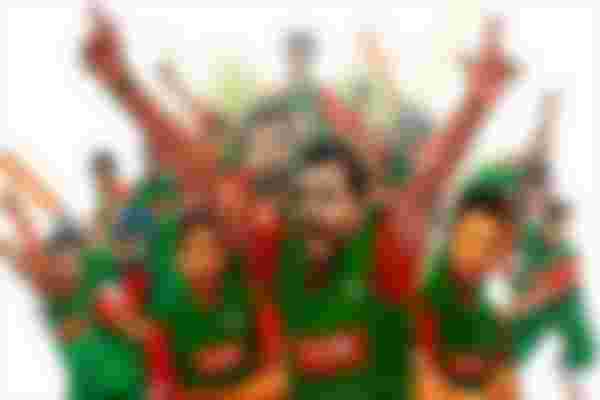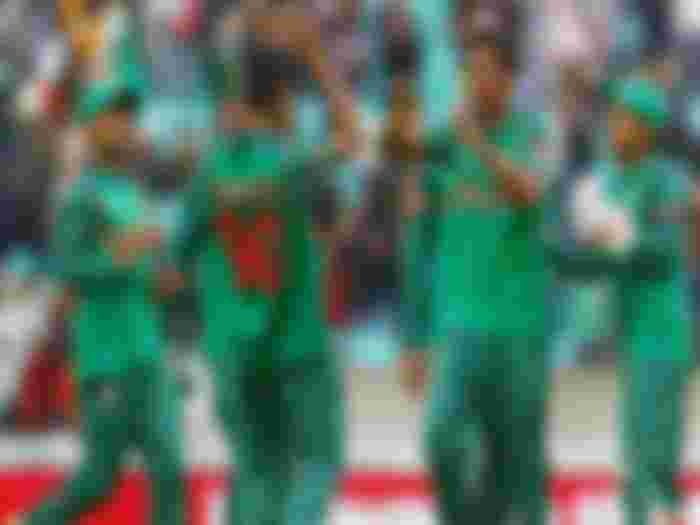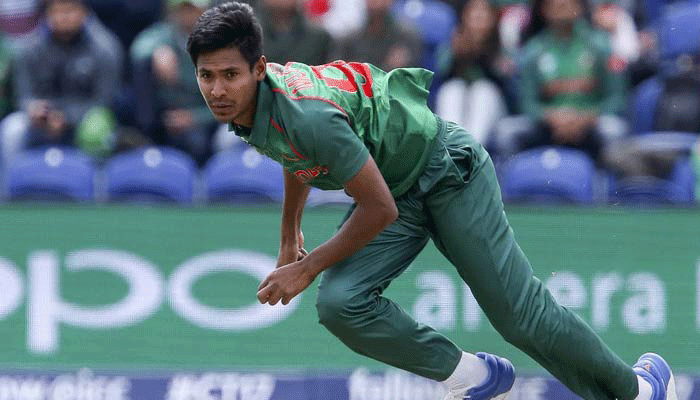*Good Morning all Friends.I am Rabiul Hasan. How are all? I am also fine.
*Now I am write an article it is the International Games Cricket Games.
★Cricket Games★

*Cricket is a team game of bat and ball in which two teams of eleven players take part. The game originated in England. Later, the game spread to other countries, including the British colonies. Currently, England, Australia, New Zealand, South Africa, India, Sri Lanka, Bangladesh, Pakistan, West Indies, Zimbabwe, Afghanistan and Ireland play five-day Test cricket in the international arena.
*Zimbabwe voluntarily withdrew from Test cricket in 2005 and returned to the game in 2011. In addition, several other countries are members of the International Cricket Council (ICC). In addition to the Test playing nations, two other ICC-sanctioned nations, a total of 12 nations, participate in one-day international cricket. A player who participates in or plays cricket is known as a cricketer.

*Bowler Shaun Pollock is bowling to batsman Michael Hussey. The grassless part in the middle is called the cricket pitch. The wicket is the two sets of wooden stamps in the middle of the pitch. The two white lines are the crease.
*A Test match between South Africa and England in January 2005. The people wearing black pants on the right are the umpires. Test cricket, first-class cricket and club cricket are traditionally played in white and also in red. Nowadays, colored clothes and white balls are used in day and night games including one-day games.

*A one-day international cricket match between Australia and India in Melbourne. Batsmen wear yellow, fielders wear blue.
* A Twenty20 match between England and Sri Lanka in Hampshire. Twenty20 matches of 20 overs usually start in the evening and last for two and a half to three hours.

*Cricket is played on a grassy field (usually oval or oval) with a 22-yard grassless section in between, called a pitch. At each end of the pitch are three long wooden sticks or stamps. On top of the three stamps or on the head are two small pieces of wood or bails. This wooden structure with stamp and bail is called wicket.
*One of the two participating teams in cricket is batting and the other is fielding. There are two batsmen on the field for the batting team. However, if for any reason the batsman is unable to run, an additional player of the batting team may come on the field. He is known as Runner. Eleven players from the fielding team are present on the field. A player on the fielding team (bowler) throws a wooden or cork ball wrapped in a hand-shaped round hard leather intended for the opposing team's player (batsman). Usually the thrown ball falls to the ground once, jumps and swings or goes straight to the batsman. The batsman tackles a delivered ball with a wooden cricket bat, called batting. If the batsman is not out, two batsmen can run between two wickets and run by changing the edge to bat. The other ten players in ball throwing are known as fielders. The one who is behind the wicket with gloves or gloves is called the wicket keeper. The team that can score more wins.

*Winning in ODI cricket is of two types: -
(a) by a run and
(b) by a wicket.
*An example of a run-scoring victory is -
Batting first, Bangladesh scored 311 runs for the loss of 4 wickets in 50 overs. Australia then scored 210 runs for the loss of all wickets or 10 wickets in 48 overs. As a result, Bangladesh will win against Australia by 101 runs.
* Examples of wins are -
Batting first, Australia lost 8 wickets in 50 overs and scored 236 runs. Later Bangladesh team lost 3 wickets in 36: 5 overs and scored 239 runs. As a result, Bangladesh will win against Australia by 8 wickets.

*Cricket has been established as a team sport for hundreds of years. The game is most popular in England and the Commonwealth. Cricket is the most popular sport in various South Asian countries such as Bangladesh, India, Pakistan and Sri Lanka. Cricket is a major sport in the English-speaking island states of England and Wales, Australia, New Zealand, South Africa, Zimbabwe, Bermuda and the Caribbean. The Caribbean countries play cricket together in the world called West Indies. Various non-professional cricket clubs have been established in the Netherlands, Kenya, Nepal and Argentina. There are also more than 100 cricketing nations that are members of the ICC, the governing body of world cricket.

*Cricket has been the subject of much political controversy at various times, the most infamous being the Basil D'Oliveira scandal for which South Africa was expelled from world cricket. England's bodyline series against Australia and underarm bowling between Australia and New Zealand are also notable.
★Description★

*A cricket ball. The white stitched part is known as the seam
*White balls are usually used in one-day games.

*The aim of the batting team is to run as fast as possible. Runs occur when both batsmen change edges between themselves on the wicket. (Usually the batsman tries to take a run after dealing with the ball, but this is not necessary.) In addition, if the batsman can send the ball outside the boundaries of the field, runs are also made. If the ball goes out of bounds without touching the field, six runs are given and if the ball touches the field and crosses the boundary, four runs are given. Besides, even if the bowler does not bowl according to the rules, runs are given.
The purpose of the bowling team is to get all the batsmen out of the batting team out (also known as wickets, or dismissals). Batsmen can be out in a variety of ways. The best way is for the bowler to throw the ball in such a way that the batsman cannot play the ball properly and the ball hits the stumps and throws the bail. This type of out is called bold. When the batsmen run, the fielders throw the ball and try to throw the bail from the stumps before the batsman reaches the crease. This is known as run out. Other out-of-the-box methods include catching the batsman's tackled ball before it hits the ground, which is known as a cut-out, and putting the ball on the batsman's leg results in LBW. Or is thrown out of the leg before wicket. The ball is declared "dead" when the batsman does not try to run again after dealing with a ball and taking a run, and another ball is thrown instead.

The game is played over six (valid) ball overs. There are different types of overs in different types of games. At the end of the over, the batting and bowling team changes sides and the fielding team has to change the bowler. This time the two umpires changed their position.
When one batsman is out, another batsman takes his place. The team's innings ends when the tenth batsman of the batting team is out. Ten batsmen are all out. (In limited overs cricket, an innings ends if a team is all out or the team plays a predetermined number of overs.) At the end of the innings, the batting team fielding and the fielding team batting.
Usually the team that scores the most runs wins. However, the definition of victory is different in different situations. For example, the number of overs played in limited overs may be reduced due to rain, or the winner may be determined using the Duckworth-Lewis method.
★Results★

*If everyone is dismissed for less than the run scored by the opposing team at the end, the team is said to have "lost" (n) (where (n) indicates the difference between the runs of the two teams). If the team batting at the end scores more runs than the opposing team before they are all out, then that team is said to have "won by (n) wickets" (where (n) indicates the difference between 10 and how many wickets the winning team has taken).

*In games where each team has two innings, if a team cannot score the same number of runs in the first innings as the first and second innings, and all are out in the second innings, then the opposing team no longer has to bat and they (n) ) Is said to have won the run (where (n) indicates the difference between the runs of the two teams).
*If the runs of both the teams are equal after all the batsmen are out then there is a tie. The tie is almost invisible in each team's two-innings game. In a conventional game, if neither team wins within the allotted time, the game is declared a draw.

*Games in which a team plays only one innings are usually limited to a certain number of overs. These are known as limited overs or one day games. The team that scores more runs wins and the result of this game is not worth the wicket, so there is no draw in these games. If the game is temporarily disrupted due to weather, the winning goal is redefined through a formula called the Duckworth-Lewis method. The outcome of a one-day game can be unresolved if neither team can play a minimum number of overs. This usually happens due to bad weather.
★Cricket legislation★

*There are 42 cricket laws in the game of cricket, which have been formulated by the Marylebone Cricket Club in consultation with various major cricketing countries. In a particular game, the teams can unanimously change or violate any law. Other laws are complementary to the main law and are used to deal with different situations. It may be mentioned here that in recent times, there are some restrictions being imposed on the fielding team to make cricket more attractive in the limited overs game.
★Players★
*A team consists of eleven players. They can be classified as expert batsmen or bowlers depending on their playing skills. A well-balanced team usually has five to six specialist batsmen and four to five specialist bowlers. Each team has an expert wicket keeper. Recently the idea of expert fielders has been introduced and is gaining equal importance. Each team has a captain who makes important decisions on the field.

*A player who is equally adept at both bowling and batting is known as an all-rounder. A person who specializes in batting and wicket-keeping is known as a wicket-keeper-cum-batsman, who is sometimes considered a special type of all-rounder. True all-rounders are valuable players in the team, but they are rarely seen. Most of the players either pay more attention to batting or bowling.
★The umpire★

*Every game has two umpires on the field who manage the game. An umpire (field umpire) is behind the wicket at the end from which the bowler bowls. He made most of the decisions on the field. The other umpire (square leg umpire) is in a square leg position on the field, so that he can see the batsman from the side and help the field umpire in the decisions he makes.

In professional play, there is an extra umpire off the field who is known as the third umpire or third umpire. Field umpires may, if necessary, enlist the help of a third umpire who makes the decision after watching a re-broadcast on television. International matches have an off-field match referee who monitors whether the game is governed by the rules of cricket.
★Scorer★

Usually each team appoints one or two scorers. Under the rules of cricket, the official scorer records how many runs have been scored, how many wickets have been taken, and how many overs have been played. They look at the umpire's signal and match the score with the umpire at the break of the game to see if it's okay. In reality, scorers record many more things, such as the bowler's bowling statistics, the rate at which a team has bowled, and the different averages and statistics of the teams. In international and national cricket competitions, the media has to know different records and statistics, so unofficial scorers are kept at different times for commentators, journalists and broadcasters. Official scorers sometimes make mistakes, but the difference with umpire mistakes is that they can be corrected after an incident.
Melbourne Cricket Ground during the 1992 Cricket World Cup
★Playground★

The cricket ground is built on a huge round or oval grassy ground. Although there are no specific rules for the size of the field, it is usually between 450 feet (138 m) and 500 feet (150 m) in diameter. Most of the fields are surrounded by ropes which is known as boundary.
★Pitch ★



*Most of the cricket events take place in the middle of the field which is usually a small piece of grass or a grassless square. This is called pitch. The pitch measures 10 × 6 feet (3.05 × 20.12 m).
*At each end of the pitch, three steep wooden bars are fastened to the ground, known as stumps. Above the stamp are two pieces of wood known as bails., On two stamps are attached two bail stamps. In cricket, it is mandatory to throw a bail in case of being stamped out. The aggregate set of three stamps and two bails is known as wicket. One end of the pitch is called the batting edge, the edge at which the batsman stands and the other end is called the bowling edge from which the bowler runs and bowls. The field is divided into two parts by a connecting line of two wickets; The side where the batsman holds the bat is called off side and the side where the batsman has legs is called on side. In other words, the right side of a right-handed batsman and the left side of a left-handed batsman is off side and the other is on side or leg side.
*The line drawn on the pitch is called the crease. The crease is used to check if the batsman is out. The crease is also used to check whether the bowler has bowled a valid ball.

★History★
No such history is known. However, it is known that this game was first played in England.
So cricket is a international Game. I like cricket so much. Can you like it? please comment me in my article comment box.
sir,
@MarcDeMesel, @TheRandomRewarder @scottcbusiness, @RogerVer, @georgedonnelly
I hope we are liked my article.
Thanks all reader and waiter.

















Boys really like to play cricket Cricket is a favorite sport of boys' childhood as I actually miss a lot of cricket games now to play in IPL I wrote a thank you note to a cricketer who left his childhood days